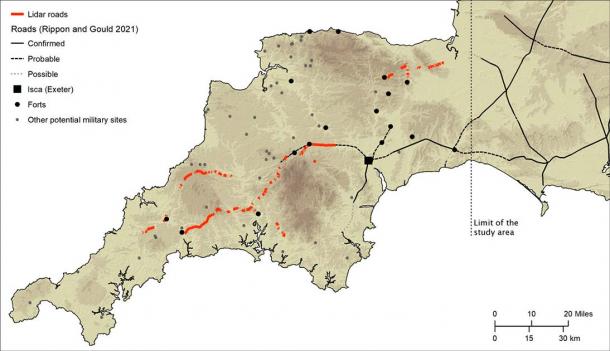Extensive Roman Road Network Covering Devon and Cornwall Revealed in UK
A Roman road network crossing Devon and Cornwall in the UK connecting significant settlements with military forts across the two counties as well as wider Britannia has been revealed for the first time. Roman roads, or viae, as they were called, remain a shining example of the civil and engineering prowess of the ancient Romans, as well as serving to carry this expertise across their vast empire.
As part of the findings, it was learnt that Exeter was not the main nerve center of the network as previously imagined, but rather, North Tawton. Additionally, it was found, that one of the primary objectives of the network was to enable the smooth movement of animal-drawn vehicles and to bypass flood-prone areas.
- The Secret that Enabled Roman Roads to Withstand the Passage of Time
- Study Reveals Lasting Prosperity Along the Roman Road Network

Full road network incorporating fuzziness around paths. (Smart et al. / University of Exeter)
The Use of Light Detection and Ranging: A Hidden Network of Viae
Archaeologists from the University of Exeter have harnessed advanced laser scanning technology and sophisticated geographical modelling techniques, as part of the Environment Agency's National LiDAR Programme to uncover previously unknown sections of these ancient roads for the first time! Their finds have been published in the Journal of Computer Applications in Archaeology.
Led by Dr. Christopher Smart and Dr. João Fonte from the Department of Archaeology and History and aided by Dr. César Parcero Oubiña from the Institute of Heritage Sciences, Spanish National Research Council, the researchers employed innovative geographical modeling techniques that incorporated factors like gradients and flood risk.
The groundwork for this discovery was laid by the National LiDAR (Light Detection and Ranging) Programme, conducted between 2016 and 2022 by the Environment Agency. The initiative covered the entire expanse of England, and the resultant data, available through the DEFRA Data Services Platform, vastly expanded the mapped terrain of Devon and Cornwall from a mere 11%, according to a University of Exeter press release.
Collaborating with public volunteers and supported by the National Lottery Heritage Fund's Digital Skills for Heritage initiative, the Exeter team meticulously examined the scans. Through their combined efforts, they managed to chart approximately 100km (62 miles) of additional Roman roads.
- Unique 2,000-Year-Old Roman Road Accidentally Uncovered in Worcestershire
- The Roman Legions: The Organized Military Force Of The Roman Empire

New parts of the Roman road network in Devon and Cornwall revealed by LiDAR. (Smart et al. / University of Exeter)
Challenging the Traditional Knowledge Systems: From Exeter to North Tawton
The new finds helped challenge traditionally held assumptions about the expanse of this network. Contrary to prior belief, the research indicates that North Tawton, not Exeter, served as a strategic hub for connections with tidal estuaries to the north and south of Bodmin and Dartmoor.
“Despite more than 70 years of scholarship, published maps of the Roman road network in southern Britain have remained largely unchanged and all are consistent in showing that west of Exeter - Roman Isca - there was little solid evidence for a system of long-distance roads. But the recent availability of seamless LiDAR coverage for Britain has provided the means to transform our understanding of the Roman road network that developed within the province, and nowhere more so than in the far south western counties, in the territory of the Dumnonii,” explained Dr. Smart.
While this achievement marked a significant step forward, the overall image remained fragmented, with sizable portions of the map devoid of evidence of Roman roadways, reports the BBC. To address this, the team devised a geographic information system predictive model to intelligently fill the gaps in our understanding.
Leveraging Least Cost Paths—the most efficient connections between various points—along with other methodologies such as focal mobility networks and transit corridors, the researchers pinpointed primary and secondary 'nodes' across the two counties. Notable features included permanent military fortifications and settlements like Exeter and North Tawton. By calculating the most feasible routes between these points, the team managed to identify an additional 13km (8 mi) of Roman roads that closely aligned with the model's predictions.

Examples of segments of Roman roads identified from the LiDAR-derived terrain models provided by Environment Agency’s ‘National LiDAR Programme’. (Smart et al./ National LiDAR Programme/ Journal of Computer Applications in Archaeology)
Along the Way: Uncovering Secondary and Tertiary Routes
“In terms of chronology, it is likely that the proposed network is an amalgam of pre-existing Prehistoric routeways, Roman military campaign roads or “tactical roads” formally adopted into the provincial communications system, and of those constructed during peacetime in a wholly civilian context,” says Dr Fonte. “This evolutionary model is supported by the fact that the network does not solely connect Roman forts and their hinterlands directly, which are often connected by branch roads, but instead appears to serve a broader purpose than required by military supply.”
In the concluding phase, the researchers expanded the road network to areas beyond the established Roman sites in the region, revealing secondary or tertiary routes that complemented the main paths. This unveiling of new ‘terminal points’ particularly along Cornwall's southwestern coast, hinted at a broader purpose for the network beyond what was previously understood.
Ultimately, the study suggests that the main objective of the Roman road network was to facilitate the movement of animal-drawn vehicles and circumvent flood-prone areas. This changes the way entirely that the Roman road network is looked at and understood, paving the way for future researchers.
“This network, identified by the scans and the GIS-enabled modelling, may serve to predict the location of settlements that are as yet unknown to us. New archaeological evidence, including that proposed here for the existence of a wide-reaching Roman road network, urges for a reconsideration of the degree of capital investment in infrastructure and the development of a more complex settlement network hierarchy in the Roman South West Britain,” concludes Dr. Smart.
Top image: Roman soldiers marching along a Roman road. Source: mehaniq41/Adobe Stock
By Sahir Pandey
References
BBC. 2023. Roman road network identified in Devon and Cornwall. Available at: https://www.bbc.com/news/articles/c16ey7ryd38o.
Merrington, A. 2023. Roman road network spanning the South West identified in new research. Available at: https://news.exeter.ac.uk/faculty-of-humanities-arts-and-social-sciences/roman-road-network-spanning-the-south-west-identified-in-new-research/.
Milligan, M. 2023. ARCHAEOLOGISTS IDENTIFY ROMAN ROAD NETWORK. Available at: https://www.heritagedaily.com/2023/08/archaeologists-identify-roman-road-network/148177.
Minchin, R. 2023. Roman road network spanning the south west of England identified in new research. Available at: https://www.independent.co.uk/news/uk/roman-devon-exeter-university-of-exeter-england-b2388780.html.
Parcero-Oubina, C., et al. 2023. Remote Sensing and GIS Modelling of Roman Roads in South West Britain. Available at: https://journal.caa-international.org/articles/10.5334/jcaa.109.

















